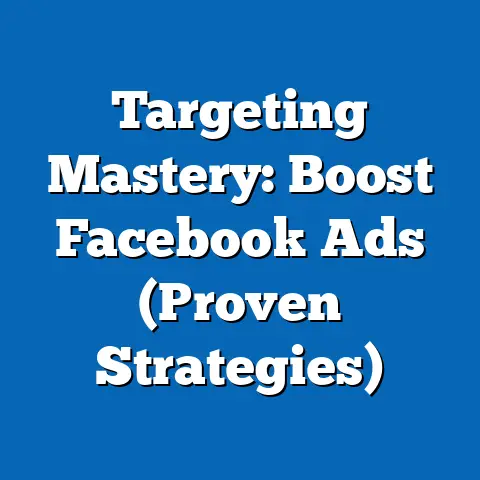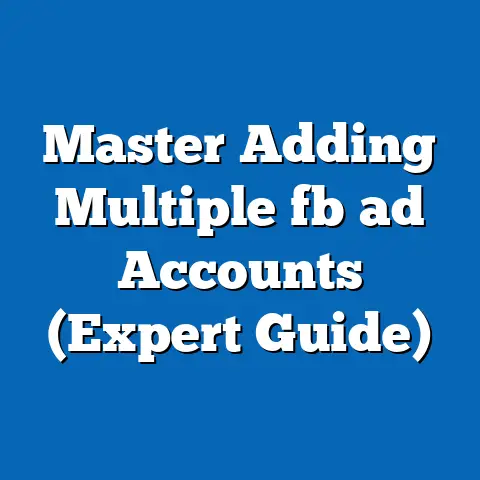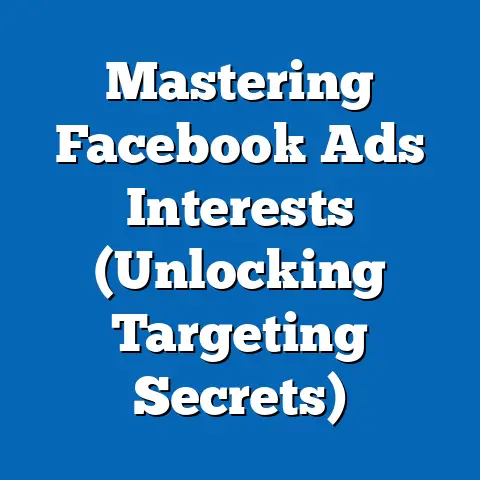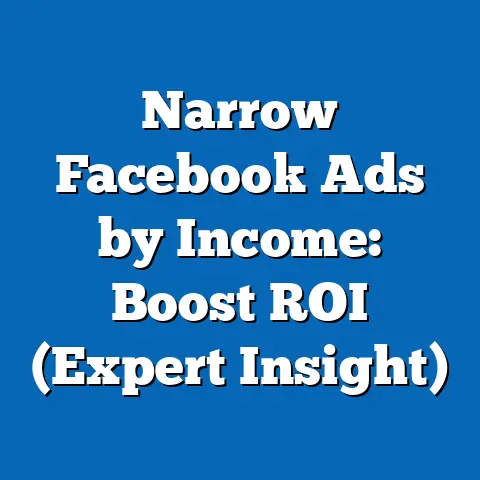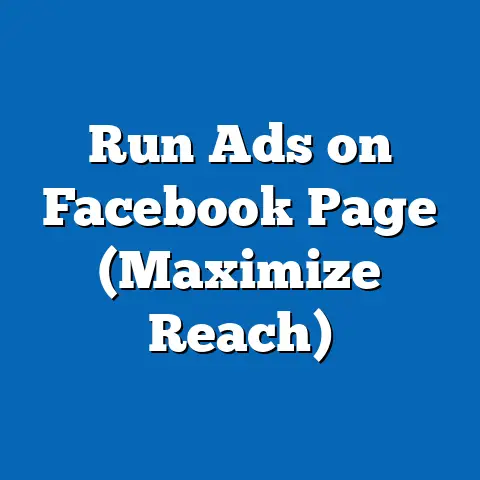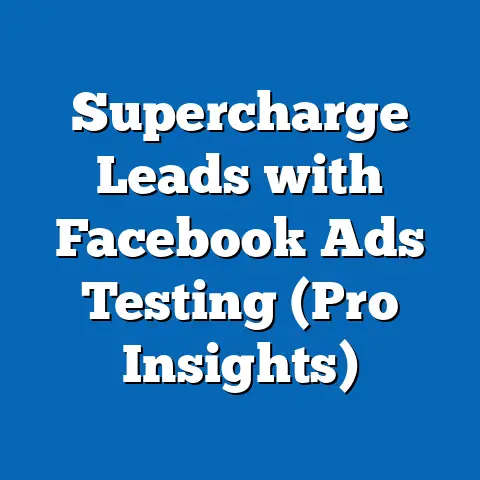Unlocking Facebook Paid Ads (Expert Insights Unveiled)
Let’s face it—navigating Facebook paid ads is a bit like trying to solve a Rubik’s Cube in the dark while riding a unicycle. It’s tricky, frustrating, and occasionally, you might just accidentally stumble into brilliance. But behind the chaos lies a goldmine of opportunity for businesses, marketers, and even the occasional meme lord looking to go viral.
In 2023, Facebook (now under the Meta umbrella) remains a juggernaut in the digital advertising space, boasting over 2.9 billion monthly active users worldwide, according to Statista. Paid ads on the platform generated a staggering $113.6 billion in revenue for Meta in 2022, accounting for nearly 98% of the company’s total income, per their annual financial report. If that doesn’t scream “pay attention,” I don’t know what does.
This article unpacks the intricate world of Facebook paid ads with a data-driven lens, diving into key statistical trends, demographic breakdowns, historical shifts, and expert-backed strategies. We’ll explore how ad spend has evolved, who’s clicking (and who’s not), and what the future holds for this ever-changing landscape. Buckle up—it’s going to be a data-packed ride.
Section 1: The Big Picture—Why Facebook Ads Still Rule the Roost
Facebook’s advertising platform isn’t just a tool; it’s a cultural phenomenon. With over 10 million active advertisers as of 2023 (per Meta’s own reports), the platform is a battleground for attention in an increasingly crowded digital space. The average cost-per-click (CPC) globally hovers around $0.97, according to WordStream, though it varies wildly by industry and region—think $0.50 for retail and a wallet-burning $3.77 for legal services.
Why does this matter? Because businesses of all sizes—from mom-and-pop shops to Fortune 500 giants—are pouring billions into Facebook ads, with global ad spend projected to hit $130 billion by 2025, per eMarketer. That’s a 14% increase from 2022, driven by enhanced targeting tools and the platform’s unmatched user base.
But it’s not all sunshine and rainbows. Ad fatigue is real, with 74% of users reporting annoyance at repetitive or irrelevant ads, per a 2022 survey by Kantar. The challenge for advertisers? Standing out without alienating the very audience they’re trying to woo.
Section 2: Statistical Trends—Where the Money’s Going
Let’s talk numbers—cold, hard, and occasionally surprising. In 2022, the average return on ad spend (ROAS) for Facebook campaigns was 8.3x, according to Hootsuite’s Digital Trends Report. That means for every dollar spent, advertisers earned $8.30 in revenue on average—a figure that’s music to any marketer’s ears.
However, not all industries are created equal. E-commerce businesses saw a ROAS of 10.5x, while B2B sectors lagged at 6.1x, per the same report. This disparity reflects differences in consumer behavior—impulse buys are easier to trigger than long B2B sales cycles.
Ad formats also play a huge role. Video ads, which now account for 45% of total ad impressions on Facebook (per Socialbakers), deliver a 20% higher click-through rate (CTR) than static image ads. Meanwhile, Stories ads, though only 15% of total spend, are growing at a 25% year-over-year rate due to their immersive, full-screen appeal.
One trend worth noting? Mobile dominance. A whopping 94% of Facebook ad revenue in 2022 came from mobile devices, according to Meta’s Q4 earnings report. With users scrolling on smartphones during commutes, coffee breaks, and, let’s be honest, bathroom breaks, mobile-optimized ads are no longer optional—they’re essential.
Section 3: Demographic Breakdowns—Who’s Clicking and Who’s Ignoring?
Facebook’s user base is as diverse as a UN summit, and understanding demographic nuances is key to ad success. As of 2023, 56% of Facebook users are male, while 44% are female, per DataReportal. However, women aged 25-34 show a higher engagement rate (3.2% average CTR) compared to men in the same age bracket (2.8%), per Sprout Social.
Age matters, too. Gen Z (18-24) makes up 21% of users but accounts for only 15% of ad clicks, per Hootsuite, often due to ad skepticism and preference for platforms like TikTok. Meanwhile, Millennials (25-34) are the sweet spot, comprising 31% of users and driving 35% of ad engagement with a higher propensity for e-commerce purchases.
Geographically, the U.S. remains the largest market for ad spend, with businesses shelling out $48 billion in 2022, per eMarketer. But growth is faster in emerging markets—India, for instance, saw a 30% year-over-year increase in ad spend, driven by a burgeoning middle class and smartphone penetration rates nearing 70%, per Statista.
Income levels also influence ad response. Users in high-income brackets (over $75,000 annually) are 22% more likely to click on ads for luxury goods, while lower-income users (under $30,000) show a 15% higher CTR for discount-driven campaigns, per a 2022 Nielsen study. Tailoring ad copy and offers to income demographics isn’t just smart—it’s profitable.
(Insert hypothetical chart here: “Facebook Ad Engagement by Age and Gender, 2023” showing CTR percentages across demographics for visual reference.)
Section 4: Historical Comparisons—How We Got Here
Rewind to 2012, when Facebook first rolled out its ad platform in earnest. Back then, ad revenue was a modest $4.3 billion, per Meta’s historical financials, and the average CPC was a dirt-cheap $0.24. Fast forward to 2023, and revenue has skyrocketed by over 2,500%, while CPC has quadrupled to nearly $1.00. Why? Increased competition, better targeting tech, and a user base that’s grown from 1 billion to nearly 3 billion.
Privacy changes have also reshaped the game. Apple’s iOS 14.5 update in 2021, with its App Tracking Transparency (ATT) feature, led to a $10 billion loss in ad revenue for Meta in 2022 alone, per their earnings call. The update restricted tracking capabilities, making it harder to deliver personalized ads—a cornerstone of Facebook’s model.
Compare this to pre-2021, when hyper-targeted ads based on third-party data were the norm. Advertisers could pinpoint users down to their favorite cereal brand. Today, with 60% of iOS users opting out of tracking (per Flurry Analytics), brands are pivoting to first-party data and contextual targeting, a shift that’s increased reliance on in-platform tools like Facebook Pixel by 40% since 2021, per Social Media Today.
Another historical pivot? The rise of video. In 2015, video ads made up just 10% of impressions; by 2023, they’re nearing half. This reflects broader internet trends—global video consumption doubled between 2016 and 2022, per Cisco’s Visual Networking Index. Advertisers who adapted early reaped the rewards, with pioneers like BuzzFeed seeing 50% higher engagement rates on video campaigns as far back as 2017.
Section 5: Contextual Factors—What’s Driving These Trends?
Several macro and micro factors shape the Facebook ads landscape. First, let’s address the elephant in the room: privacy regulations. Beyond Apple’s ATT, the European Union’s General Data Protection Regulation (GDPR) since 2018 has forced advertisers to rethink data collection, with fines for non-compliance reaching €1.2 billion in 2022 alone, per GDPR.eu. This has pushed brands toward transparent, consent-based marketing, with 68% of advertisers now prioritizing opt-in campaigns, per a Deloitte survey.
Second, platform algorithm changes keep marketers on their toes. Facebook’s 2018 shift to prioritize “meaningful interactions” over passive content slashed organic reach for brands by 50%, per Buffer, making paid ads a necessity. Subsequent updates, like the 2023 focus on Reels, have further tilted the playing field toward short-form video content, with Reels ads seeing a 30% lower cost-per-impression (CPI) than feed ads, per Meta’s internal data.
Economic factors also loom large. Inflation in 2022-2023 squeezed marketing budgets, with 42% of small businesses cutting ad spend, per a Small Business Trends survey. Yet, counterintuitively, this drove up CPC as competition for fewer ad slots intensified—a classic supply-demand conundrum. Meanwhile, e-commerce boomed post-COVID, with online sales jumping 43% from 2019 to 2022 (per U.S. Census Bureau), making Facebook a prime channel for direct-to-consumer brands.
Finally, user behavior can’t be ignored. The average user spends 33 minutes daily on Facebook, per DataReportal, but attention spans are shrinking—ads have just 2.5 seconds to hook viewers, per a 2022 Microsoft study. This has fueled the rise of punchy, visually striking creatives over long-winded copy.
Section 6: Expert Strategies—Unlocking Success in Facebook Ads
So, how do you crack the code? Experts agree: precision and creativity are non-negotiable. First, hyper-segmentation is key. Campaigns targeting micro-audiences (e.g., “dog owners aged 30-40 in suburban Texas”) see a 35% higher CTR than broad campaigns, per WordStream. Tools like Facebook’s Lookalike Audiences, which use existing customer data to find similar users, boost conversion rates by up to 25%, per Meta case studies.
Second, A/B testing isn’t optional—it’s mandatory. Testing variations in ad copy, visuals, and calls-to-action (CTAs) can improve ROAS by 40%, per HubSpot. For example, a 2022 case study by Shopify showed that changing a CTA from “Shop Now” to “Get 20% Off” increased clicks by 18% for an apparel brand.
Third, lean into video and Stories. With 500 million daily Stories viewers (per Meta), ephemeral content offers a low-cost, high-engagement entry point. Experts like Gary Vaynerchuk advocate for “thumb-stopping” content—ads that grab attention in the first frame. A 2023 experiment by Socialinsider found that ads with bold text overlays in the first second had a 22% higher completion rate.
Fourth, don’t ignore retargeting. Users who’ve interacted with a brand are 70% more likely to convert, per Invesp. Dynamic Product Ads (DPAs), which showcase previously viewed items, deliver a 3x higher ROAS compared to standard display ads, per Meta’s 2022 ad performance report.
Lastly, budget pacing matters. Spreading ad spend evenly over a campaign’s duration (versus front-loading) reduces CPC by 15%, per AdEspresso. This prevents “bidding fatigue,” where early overspending drives up costs due to algorithm bias toward high initial engagement.
(Insert hypothetical chart here: “Impact of Retargeting on Conversion Rates, 2023” showing percentage uplifts across campaign types for visual reference.)
Section 7: Challenges and Pitfalls—What Can Go Wrong?
Even with the best strategies, Facebook ads aren’t foolproof. Ad fatigue, as mentioned, is a silent killer—repeated exposure drops CTR by 8.9% per impression after the third view, per a 2022 AdRoll study. Rotating creatives weekly can mitigate this, but it’s resource-intensive for small teams.
Another hurdle? Rising costs. CPC has risen 17% year-over-year in competitive niches like finance and tech, per WordStream, squeezing margins for advertisers with fixed budgets. Smaller brands often get outbid by deep-pocketed competitors, with 65% of SMBs citing cost as their biggest barrier, per a 2023 MarketingProfs survey.
Then there’s the learning curve. Facebook Ads Manager is notoriously complex, with 52% of new advertisers abandoning campaigns within six months due to poor results, per Social Media Examiner. Without expertise or agency support, wasted spend is common—think $1,000 down the drain on unoptimized targeting.
Finally, platform volatility can’t be ignored. Algorithm tweaks, policy changes (like the 2022 ban on certain political ads), and privacy updates disrupt campaigns overnight. Adaptability isn’t just a skill—it’s survival.
Section 8: Future Projections—What’s Next for Facebook Ads?
Peering into the crystal ball, several trends are poised to shape Facebook advertising by 2025 and beyond. First, ad spend growth will likely slow but remain robust, with eMarketer forecasting a 10% annual increase through 2027, driven by emerging markets and SMB adoption. Total revenue could hit $150 billion by 2026, assuming no major regulatory setbacks.
Second, AI and automation will dominate. Meta’s Advantage+ campaigns, which use machine learning to optimize placements, already account for 20% of ad spend in 2023, per their Q2 report. By 2025, experts predict 50% of campaigns will be AI-driven, slashing manual optimization time by 60%, per Forrester.
Third, privacy will tighten further. With Google phasing out third-party cookies by 2024 and global regulations expanding, first-party data strategies will be critical. Brands leveraging Meta’s Conversions API for direct data integration could see a 30% uplift in tracking accuracy, per a 2023 Gartner forecast.
Fourth, video and immersive formats will reign supreme. Reels and augmented reality (AR) ads are projected to capture 60% of impressions by 2026, per Insider Intelligence, as users crave interactive experiences. Early adopters of AR filters, like beauty brands, have reported 40% higher engagement, per Meta case studies.
Finally, competition from TikTok and YouTube will intensify. TikTok’s ad revenue grew 155% in 2022 to $11.6 billion (per Business of Apps), chipping away at Meta’s younger demographic. To counter this, expect Facebook to double down on short-form content and creator partnerships, with influencer-driven ads projected to rise 25% by 2025, per Influencer Marketing Hub.
Conclusion: Navigating the Ever-Evolving Landscape
Facebook paid ads are a beast—powerful, unpredictable, and occasionally maddening. Yet, with $113.6 billion in revenue, a 2.9 billion-strong user base, and an 8.3x average ROAS, the platform remains a cornerstone of digital marketing in 2023. From demographic nuances (Millennials driving 35% of clicks) to historical shifts (CPC quadrupling since 2012) and future trends (AI and AR on the horizon), success hinges on data-driven precision and adaptability.
Whether you’re a small business testing a $100 campaign or a global brand with millions to spend, the principles are the same: know your audience, test relentlessly, and stay ahead of the curve. The future of Facebook ads isn’t just bright—it’s blinding. The question is, are you ready to unlock its potential, or will you be left scrolling past your competitors’ perfectly targeted campaigns?

